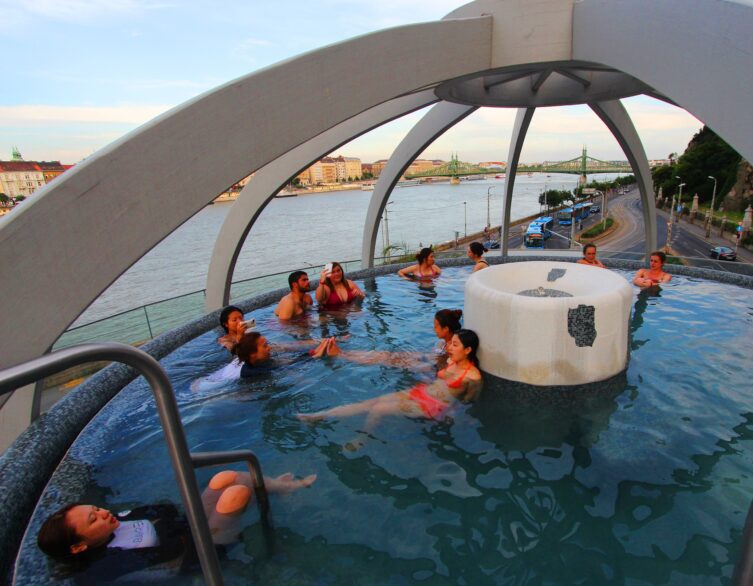Rudas Bath: A Historical and Architectural Gem in Budapest

Budapest, the City of Baths, is home to numerous bathing palaces, and among them, Rudas Bath stands out as a popular medieval Turkish bath. With its rich history, stunning architecture, and modern facilities, Rudas Bath offers a unique experience for foreign tourists visiting Hungary.
Historical Significance
Rudas Bath, one of the most popular medieval Turkish baths in Budapest, has a rich history dating back to the 16th century. The bath was commissioned by Sokollu Mustafa Pasha, the governor (beylerbey) of Buda between 1566 and 1578, during the time of Ottoman rule in Hungary. The design and dimensions of Rudas Bath echo similar monumental Ottoman constructions in Istanbul, as Sokollu Mustafa Pasha was the nephew of Grand Vizier Sokollu Mehmed Pasha.
However, the history of the site goes back even further. During the reign of King Béla IV, the area around Gellért Hill began to develop significantly. The Knights of St. John built a hospital and bath at the current location of Rudas, which the Turks also used until the construction of Rudas Bath.
The centerpiece of the bath today, the Turkish bath, was built during the 16th century. It features an octagonal pool under a 10-meter diameter dome, supported by eight pillars. Many of the key elements of a hammam, such as the Ottoman dome and octagonal pool, are still preserved.
In 1896, a swimming pool operating as a therapeutic swimming facility with a sauna was added to the complex. From 1936 until recently, the thermal bath was exclusively visited by men. In the drinking hall, visitors can consume the water from the Hungária, Attila, and Juventus springs for the purposes of a drinking cure.
The bath has undergone several renovations over the years, with a comprehensive interior renovation completed in early 2006. In 2014, Rudas Bath was expanded with a modern wellness section, featuring new pools and a rooftop thermal water jacuzzi offering stunning views of the city.
Today, Rudas Bath continues to be a popular destination for both locals and tourists seeking relaxation and the potential health benefits of its thermal waters, which are rich in minerals such as sodium, calcium, magnesium, bicarbonate, and fluoride ions.
Architectural Significance
The Rudas Bath in Budapest is a remarkable example of Ottoman architecture, showcasing the influence of Turkish culture during their occupation of Hungary in the 16th century. As a popular destination for foreign tourists visiting the city, the Rudas Bath offers a unique glimpse into the historical and architectural heritage of Budapest.
The centerpiece of the Rudas Bath is the Turkish bath, built during the 16th century under the rule of Sokollu Mustafa Pasha, the governor of Buda. The bath features a stunning 10-meter diameter dome, supported by eight pillars, which covers an octagonal pool. This design is reminiscent of the traditional Turkish hammams and reflects the architectural style of monumental Ottoman constructions in Istanbul.
Best deals of Budapest
The Rudas Bath complex also includes a swimming pool, which was added in 1896 and serves as a therapeutic swimming facility with a sauna. The bath’s drinking hall features three springs – Hungária, Attila, and Juventus – whose waters are believed to have medicinal properties and can be consumed for drinking cures.
In 2006, the Rudas Bath underwent a comprehensive renovation, which carefully preserved its interior while modernizing its facilities. The renovation also uncovered original Turkish ceramic water pipes, further emphasizing the bath’s historical significance.
One of the most striking additions to the Rudas Bath is the modern rooftop pool, which offers breathtaking panoramic views of the Danube River and the city of Budapest. This pool seamlessly blends contemporary design with the bath’s traditional Ottoman architecture, creating a unique and unforgettable experience for visitors.
The Rudas Bath stands as a testament to the rich cultural heritage of Budapest, showcasing the enduring influence of Ottoman architecture and the city’s long-standing tradition of thermal baths. For foreign tourists, a visit to the Rudas Bath provides an opportunity to immerse themselves in the history and architectural beauty of one of Budapest’s most iconic landmarks.
Main Features and Services
Rudas Bath offers a wide range of facilities and services for visitors. The Turkish bath includes six therapy pools with temperatures ranging from 10°C to 42°C (50°F to 108°F), each believed to have medicinal properties that can help treat various ailments. The bath also features a swimming pool, saunas, steam rooms, and a modern wellness area added in 2014. The rooftop pool, open year-round, offers a breathtaking view of Budapest. Visitors can also enjoy the drinking hall, where they can consume water from the Hungária, Attila, and Juventus springs, known for their rejuvenating effects.
Pools
Turkish Bath
The centerpiece of Rudas Bath is the 16th-century Turkish Bath, featuring an octagonal-shaped pool surrounded by eight pillars and a 10-meter diameter dome. The Turkish Bath has gender-specific days, with men-only on Mondays, Wednesdays, and Friday mornings, and women-only on Tuesdays.
Thermal Pools
Rudas Bath has six thermal pools with temperatures ranging from 10°C to 42°C (50°F to 108°F). The thermal water is rich in minerals such as sulfate, calcium, magnesium, bicarbonate, and fluoride, which are believed to have medicinal properties that can help treat various ailments.
Swimming Pool
The bath complex also features a swimming pool that operates as a therapeutic swimming facility, complete with a sauna. The swimming pool has a temperature of 29°C (84°F), making it the warmest swimming pool in Budapest.
Rooftop Pool
One of the highlights of Rudas Bath is the modern rooftop panorama pool, which offers stunning views of the Danube River, Parliament, and historical bridges. The rooftop pool is open year-round and is a popular spot for relaxation.
Services
Saunas and Steam Rooms: Rudas Bath offers several saunas and steam rooms, including a hammam (Turkish sauna) and an ilidza (Turkish warm thermal spring).
Massage Treatments: Guests can indulge in various massage treatments performed by qualified massage therapists. The available massages include aroma massage and refreshing massage, which can help ensure physical and mental rejuvenation after bathing.
Drinking Hall: The bath complex has a drinking hall where guests can consume water from the Hungária, Attila, and Juventus springs for the purposes of a drinking cure.
Late Night Bathing: Rudas Bath offers a special late-night bathing experience every Friday and Saturday from 10 pm to 3 am, allowing guests to enjoy the baths and facilities during the overnight hours.
Rudas Bistro: The bath complex also features the Rudas Bistro, a high-quality restaurant that offers culinary delights. The bistro can be accessed from both the street and the bath, making it a convenient dining option for guests.
General Rules For Visitors
To ensure a pleasant and safe experience for all the guests, the bath has the following rules:
Age Restriction: The Rudas Bath is not accessible for children under the age of 14.
Pool Usage:
- Adults are not permitted to stay in the children’s pools and paddle pools.
- Please respect the designated gender-specific days in the Turkish Bath area.
Online Booking: For the Friday and Saturday night bathing sessions, tickets can only be purchased online. Please note that children under the age of 14 are not allowed to enter the Rudas Bath. Also, the bath has gender-specific days and hours, so make sure to check the schedule before planning your visit.
Hygiene:
- Entry is prohibited for visitors with fever, vomiting, diarrhea, or infectious skin or respiratory diseases.
- Wearing slippers is obligatory throughout the bath complex.
- Showering with hot water and soap is mandatory before and after using the pools and restrooms.
- Swim caps are obligatory in the swimming pools.
- Eating and drinking in the pools is not allowed.
Please note that the Rudas Bath management reserves the right to deny entry or remove any visitor who fails to comply with these rules or behaves inappropriately.
Getting There
Rudas Bath is located at the foot of the scenic Gellert Hill on the Buda side of the city, near the Erzsébet Bridge. The address is Döbrentei tér 9, Budapest, Hungary.
Public Transportation
The bath is easily accessible by public transportation. You can take the following options:
- Bus: Take bus number 7 or 107 and get off at the “Rudas Gyógyfürdő” stop.
- Tram: Take tram number 19 or 41 and get off at the “Döbrentei tér” stop.
- Metro: Take the M4 metro line and get off at the “Szent Gellért tér” stop. From there, it’s a short walk to the bath.
Parking
If you are driving, there is a paid parking lot near the bath. However, due to its central location, it is recommended to use public transportation to avoid traffic and parking difficulties.
Walking
Rudas Bath is within walking distance from several popular tourist attractions, such as the Gellért Hill, the Gellért Baths, and the Buda Castle. If you are staying in the city center, you can easily reach the bath on foot.
Nearby Attractions
Rudas Bath, one of the most popular medieval Turkish baths in Budapest, is not only a perfect spot for relaxation and rejuvenation but also an excellent starting point to explore some of the city’s most iconic attractions. Situated at the foot of the scenic Gellért Hill on the Buda side of the Danube, Rudas Bath is surrounded by a wealth of historical and cultural landmarks that are sure to captivate foreign tourists visiting Hungary.
Just a short walk from Rudas Bath, visitors can marvel at the stunning architecture of the Art Nouveau Gellert Bath, another famous bathing palace in Budapest. The bath complex, built between 1912 and 1918, features beautiful ornamental pools, stained glass windows, and intricate mosaics, making it a true feast for the eyes.
For those interested in exploring Budapest’s rich history, a visit to the Buda Castle District is a must. Located atop Castle Hill, just a short funicular ride from the Danube riverbank near Rudas Bath, the district is home to the magnificent Buda Castle, the Historical Museum of Budapest, and the charming cobblestone streets lined with colorful Baroque houses.
Another nearby attraction is the Liberty Statue and the Citadella on Gellért Hill, a tall bronze statue that offers breathtaking panoramic views of the city. Visitors can hike up the hill or take a bus to reach the statue and enjoy the stunning vistas of the Danube, the bridges, and the bustling city below.
Finally, no visit to Budapest would be complete without a stroll along the picturesque Danube Promenade, which stretches between the famous Chain Bridge and the Elizabeth Bridge, right next to Rudas Bath. The promenade offers excellent opportunities for people-watching, souvenir shopping, and admiring the beautiful architecture of the city’s riverfront buildings.
Summary
Rudas Bath is a must-visit destination for foreign tourists in Budapest, offering a unique blend of history, architecture, and relaxation. With its centuries-old Turkish bath, modern facilities, and stunning rooftop pool, Rudas Bath provides an unforgettable experience for visitors seeking to immerse themselves in the rich bathing culture of Hungary.
Image source: Rudas Bath website
















